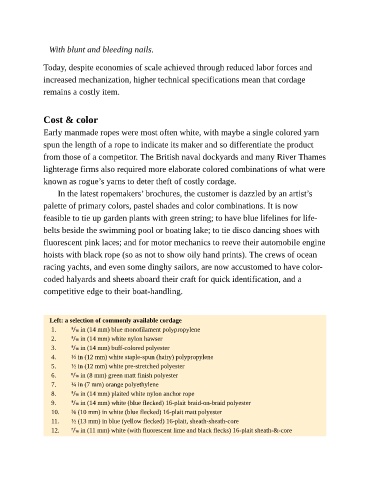Page 37 - The Pocket Guide to Outdoor Knots
P. 37
With blunt and bleeding nails.
Today, despite economies of scale achieved through reduced labor forces and
increased mechanization, higher technical specifications mean that cordage
remains a costly item.
Cost & color
Early manmade ropes were most often white, with maybe a single colored yarn
spun the length of a rope to indicate its maker and so differentiate the product
from those of a competitor. The British naval dockyards and many River Thames
lighterage firms also required more elaborate colored combinations of what were
known as rogue’s yarns to deter theft of costly cordage.
In the latest ropemakers’ brochures, the customer is dazzled by an artist’s
palette of primary colors, pastel shades and color combinations. It is now
feasible to tie up garden plants with green string; to have blue lifelines for life-
belts beside the swimming pool or boating lake; to tie disco dancing shoes with
fluorescent pink laces; and for motor mechanics to reeve their automobile engine
hoists with black rope (so as not to show oily hand prints). The crews of ocean
racing yachts, and even some dinghy sailors, are now accustomed to have color-
coded halyards and sheets aboard their craft for quick identification, and a
competitive edge to their boat-handling.
Left: a selection of commonly available cordage
1. in (14 mm) blue monofilament polypropylene
2. in (14 mm) white nylon hawser
3. in (14 mm) buff-colored polyester
4. ½ in (12 mm) white staple-spun (hairy) polypropylene
5. ½ in (12 mm) white pre-stretched polyester
6. in (8 mm) green matt finish polyester
7. ¼ in (7 mm) orange polyethylene
8. in (14 mm) plaited white nylon anchor rope
9. in (14 mm) white (blue flecked) 16-plait braid-on-braid polyester
10. ⅜ (10 mm) in white (blue flecked) 16-plait matt polyester
11. ½ (13 mm) in blue (yellow flecked) 16-plait, sheath-sheath-core
12. in (11 mm) white (with fluorescent lime and black flecks) 16-plait sheath-&-core

